Captain Boycott: man and myth
Published in 18th-19th Century Social Perspectives, 18th–19th - Century History, Features, Issue 1 (Jan/Feb 2011), Parnell & his Party, Volume 19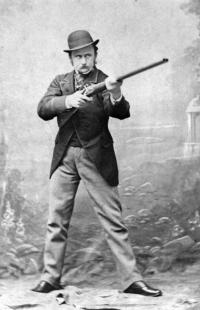
‘Captain’ Charles Cunningham Boycott, photographed in London in 1863 in a typically sporting pose. The military title was an affectation: in fact his military career was limited. (Seán Sexton/Getty Images)
By 1871 ‘Captain’ Charles Cunningham Boycott had been on Achill Island for seventeen years and had proven himself to be a good and successful farmer in a hostile and challenging environment; quite understandably, he wanted to move on to farm better land on the mainland, somewhere he could race his horses and be closer to ‘civilisation’. Moreover, his friend Murray Blacker had emigrated to the US, the island was still cut off by the sea and he had become head of his East Anglian family since the death of both his father and elder brother and wished to make himself more accessible. His opportunity came in 1872, when John Crichton, 3rd earl of Erne, who owned 40,386 acres in Ireland, 2,184 of them in Mayo, offered him the agency of his lands near the Neale, Co. Mayo, and a lease on a farm of 629 acres with a good house with yard and stables, a ruined castle, two islands, a boathouse and sporting rights.
Lord Erne preferred Englishmen or Scots in positions of authority, and the title of ‘Captain’, most likely bestowed on Boycott by the tenants for obvious reasons, may have played a part in getting him the offer. In 1870, landlords, many of them absentee, owned 80% of all the land of Ireland, while 50% of tenants occupied holdings of less than fifteen acres; more than three quarters of all holdings were annual tenancies.
On 1 May 1874 Boycott took a lease on Lough Mask House and farm for 31 years at £402 p.a. for the first nine years and £500 p.a. for the remaining 22 years, and, unknowingly, began his march into history. He had, he thought, found the home ‘where he would spend the remainder of his days’, but it was to prove to be the wrong place and the wrong time. The land at Lough Mask was much better than his holding on Achill and Boycott’s experience on the island stood to him; he farmed well and prospered. Although still only a tenant farmer himself, he was probably the biggest employer in the area and got on well with both his workers and the local people. He kept a few racehorses, which he often rode himself at local meets with some success, and hunted, shot and fished in season. It is recorded that he rode two winners on the same day at Sligo races under the colours of Lady Gore Booth. As Erne’s agent he was the ‘boss of the boss’s orders’ and had a duty to collect the rents from the other 35 tenants and generally look after the estate. At this stage, after twenty years in the county, he considered himself a Mayoman.
The Land War begins
In the late 1870s a widespread economic downturn caused a crisis in Irish agriculture; rack-renting and mass evictions were the order of the day, and famine was a constant threat in the west. James Daly, a native of Lahardane, Co. Mayo, editor and joint owner of the Connaught Telegraph newspaper, organised a mass meeting of tenants at Irishtown, Co. Mayo, on 20 April 1879 to protest against their landlord, Canon Geoffrey Bourke PP, and forced him to withdraw eviction notices and reduce rents by 25%. The Connaught Telegraph was the only Mayo paper to publish an account of this historic event. Daly had consistently highlighted Mayo tenants’ grievances and his paper was the land movement’s first and most effective propaganda vehicle for farmers in the west and elsewhere.
On 22 September David Sears, a process-server, and an escort of seventeen RIC constables began serving Lord Erne’s defaulting tenants around the Neale with eviction notices, but they were soon forced back to Lough Mask House by the local women under a shower of stones, mud and manure. It seems that at this stage ‘Captain’ Boycott had been targeted by the Land League (founded in October 1879) as a test case ‘to gain the eyes and ears of the world’, because the following day his farm was invaded by a mob of up to 100 people and his work force warned off. Local curate Fr O’Malley is reported as having congratulated them on ‘the great victory you have achieved and the noble example you have set’. There is a local legend that O’Malley had a falling out with Boycott around that time; he had sent one of Boycott’s workers, a man named Branigan, to ask the ‘Captain’ for a site for a Catholic school, and Boycott, not unreasonably, had enquired why he had not come himself. (O’Malley is also credited with coining the verb ‘boycott’, saying that the people would not be able to remember ‘ostracise’.)
Boycott now found himself in a very difficult situation, as he had horses, cattle, sheep and poultry to look after and crops to get in with very few helpers. Three of his staff refused to leave—Johnny Meany, a groom and former jockey, Judy, the cook, and Harriet, a parlour maid—and he had four guests staying at the time, a teenage niece, two teenage nephews and his niece’s fiancé. They carried on as best they could, rising at 4am, with the men being escorted everywhere by armed police, but by night fences and gates were broken, trees and hedges felled and crops stolen or ruined. Boycott was in a fix but was determined to do his duty and see it through: ‘I can hardly desert Lord Erne and moreover my own property is sunk in this place’.
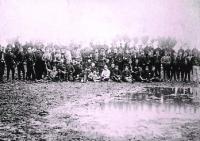
Some of the 50 volunteers of the ‘Boycott relief expedition’—mainly Orangemen from Cavan and Monaghan
‘Boycott relief expedition’
Some of the 50 volunteers of the ‘Boycott relief expedition’—mainly Orangemen from Cavan and Monaghan
William Sydney Clements, 3rd earl of Leitrim, had been ‘executed’ on 2 April 1878 at Cratlagh Wood, near Milford, Co. Donegal, after he had threatened to evict twenty families ‘before casting a fly on Lough Mask’ that year. On 25 September 1880 Lord Mountmorres was assassinated near his home at Clonbur, Co. Galway. On 14 October 1880 Boycott wrote to the London Times setting out his predicament, and on 29 October the Dublin Daily Express proposed the setting up of a fund to save Boycott’s crops. This was adopted enthusiastically in Ulster, where Lord Erne lived at Crom Castle, Co. Fermanagh, and plans were laid for the ‘Boycott relief expedition’.
Boycott needed and sought no more than about twelve men to harvest his eight
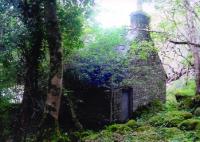
some of whom slept in the nearby boathouse
a
some of whom slept in the nearby boathouse
cres of turnips, seven acres of mangolds, two acres of potatoes and to thresh twenty acres of
already-cut corn, but by the first week in November 1880 the matter was out of his hands; the Ulster ‘Boycott relief expedition’ had organised 50 volunteers, Orangemen from Cavan and Monaghan, to ‘get in the Captain’s turnips’. One of the leaders of the expedition was a Captain Somerset Maxwell, who had been a trustee of the Achill Mission. The volunteers arrived at Lough Mask House on 12 November, escorted by a large company of soldiers, having had to walk all the way from Claremorris railway station in driving rain as none of the local drivers would carry them, and they were accommodated in tents on the lawns, in barns and in the boathouse.
There were around 900 soldiers stationed in and around Ballinrobe and the Neale for the next two weeks until the harvesting was finished, and a large number of
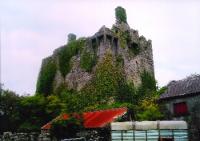
De Burgo castle at Lough Mask House. Local lore has Boycott abseiling from the chimney.
Boycott’s
De Burgo castle at Lough Mask House. Local lore has Boycott abseiling from the chimney.
sheep, fowl and other foodstuffs vanished while they were there; they also turned Boycott’s well-tended paths and lawns into an appalling quagmire. On 27 November they left along with the relief expedition, and it was reckoned that it had cost up to £10,000 to save a harvest worth at most £350. The Connaught Telegraph gave extensive coverage to the episode and, under the heading ‘OUR INVADERS’, James Daly recorded the miserable state of the rain-sodden volunteers and soldiers and, as was his wont, called for restraint by hotheads to avoid any danger of bloodshed.
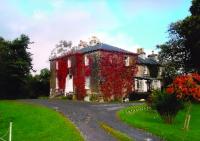
Lough Mask House today. In 1886 Boycott sold his interest in the house and surrounding farm to Bernard Daly of Ballinrobe, whose descendants have farmed there ever since.
Boycott departs and sells up
Lough Mask House today. In 1886 Boycott sold his interest in the house and surrounding farm to Bernard Daly of Ballinrobe, whose descendants have farmed there ever since.
Left without protection, and with no alternative, the following day ‘Captain’ Boycott and his wife Annie quietly and sadly left their home in an army ambulance wagon, escorted by a troop of the 19th Hussars. In Dublin they were escorted from the train to the Hamman Hotel, Upper Sackville Street, by detectives, and on 1 December 1880 they took the mail-boat to Holyhead. The affair made headlines worldwide and he was now a legendary and notorious figure. By the end of 1880 ‘boycotting’ was widespread in Ireland and further afield, and within twenty years the word would appear in dictionaries all over the world. In spring 1881, travelling as Mr and Mrs Charles Cunningham, the Boycotts sailed for the US to visit their friends Murray and Frances Blacker in Amelia County, Virginia, arriving in early April. It had been a long, hard winter for Boycott and he recovered his health and his humour on his first visit to the New World.
In August 1881 the Boycotts returned quietly to Ireland and Lough Mask House and found that nothing had been lost or stolen in their absence. It is probable that when they were forced to leave an Ulsterman was installed as caretaker, as had been the case in other similar situations. Mayo lore has it that they were warmly welcomed home by the local people. In December 1880 Boycott had written to Prime Minister Gladstone seeking £6,000 compensation for the losses that he sustained ‘due to the absence of law in the West of Ireland’. He was not successful and finally had to face the fact that he could no longer afford to stay on at Lough Mask. In 1886 the farm was bought by Bernard Daly from Ballinrobe, whose family have farmed it ever since.
Returns to East Anglia
Back in England the same year Boycott took the job of land agent to the 14,000-acre estate of Catholic landowner Sir Hugh Adair along the Norfolk/Suffolk county boundary, close to where he was born, and moved into the agent’s house in Flixton. These continued to be very bad years for farming, with cheap imports and depressed markets, and, as Adair spent much of his time away from home, the running of the estate fell to his agent. Boycott took his duties very seriously and as always he worked hard, earning a reputation for being understanding but firm. He still raced his horses under his own colours of green, with rose sleeves and a black cap, often riding himself and showing ‘indomitable pluck in the saddle’, but always lacked the money to make any real impact. When he took holidays he spent them in Ireland.
The day Charles Cunningham Boycott died, aged 65 and a ‘technical bankrupt’, nearly the whole of the Royal Navy was lined up in the Solent and beyond with its admirals and its bands; sirens sounded, flags and pennants fluttered in the warm breeze, and church bells pealed out loudly and joyfully throughout the length and breadth of the UK. It was 19 June 1897 and Queen Victoria was celebrating her diamond jubilee. Boycott’s headstone was erected by his employer, Sir Hugh Adair, but, fittingly, his burial service in Burgh-St Peter Church was conducted by the Revd Douglass Boycott, one of the nephews who had been with him during the famous ‘siege’ seventeen years earlier at Lough Mask House, the Neale, Co. Mayo. HI
Liam Ó Raghallaigh is a local historian, originally from Mayo.
Further reading:
C.A. Boycott, Boycott: the life behind the word (London, 1997).
Connaught Tribune, 1880–1881.
J. Marlow, Captain Boycott and the Irish (London, 1973).
















